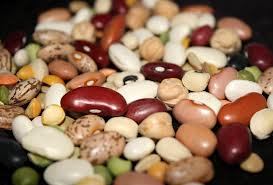
A Load of Old Beans
A Nurturing Potential report

Beans, of the leguminous or pulse variety, are one of the most healthy and nutritious cultivated crops. They are also one of the oldest cultivated crops. Archeological evidence suggests that the cultivation of beans dates from the dawn of agricultural practices.
Beans are a high soluble fibre (1) food that helps reduce cholesterol. They are rich in potassium and magnesium, both minerals that are useful in regulating blood pressure and thus effectively reducing a propensity to stroke. As an aside, they are also a useful dietary complement, being high in protein and carbohydrates, and low in fats and calories. Because they can control blood glucose levels, they are of benefit for sufferers from diabetes.
Further beneficial side effects are a healthier colon, a reduced risk of intestinal ulcers, controlling the symptoms of Irritable Bowel Syndrome, and managing diarrhoea. They are also high in antioxidants.
Some legumes contain additional nutrients, such as zinc or vitamin B6. Zinc is a mineral that contributes to tissue growth and repair; it helps keep your skin and hair healthy. This mineral is also found in the retina of the eye, where it helps fend off macular degeneration. Vitamin B6 protects against age-related memory decline.
In case this is beginning to sound like a snake-oil advertisement, there is a significant downside to this product.

Many people shun beans because of their gaseous aftereffects. Human digestive enzymes can’t break down the fibre and short chains of sugar molecules known as oligosaccharides in beans. But the billions of bacteria living in the gut can digest them, often creating gas in the process. A Harvard study recommended the following:
Soak beans. Soaking beans can get rid of a good portion of the indigestible oligosaccharides. Soak beans for 12 to 24 hours in lots of water, then pour off the water, rinse the beans, add clean water, and cook.
Choose wisely. Some beans seem to create less gas than others. These include adzuki and mung beans, lentils, and black-eyed, the Indian toor dal, and split peas. Heavy-duty gas formers include lima, pinto, haricot, and whole soy beans.
Start slowly. Let your body get used to fibre and oligosaccharides by having a small serving once or twice a week. Then gradually increase your intake, either by taking larger servings or eating beans more frequently. And increase your intake of fluids as you fibre intake increases.
Put your teeth to work. The more thoroughly you chew beans, the more you expose them to natural oligosaccharide-digesting enzymes in your saliva.
The Differences Between Soluble and Insoluble Fibre
Soluble fibre dissolves in water. Insoluble fibre does not. To some degree these differences determine how each fibre functions in the body and benefits your health.
Soluble fibres attract water and form a gel, which slows down digestion. Soluble fibre delays the emptying of your stomach and makes you feel full, which helps control weight. Slower stomach emptying may also affect blood sugar levels and have a beneficial effect on insulin sensitivity, which may help control diabetes. Soluble fibres can also help lower LDL (“bad”) blood cholesterol (2) by interfering with the absorption of dietary cholesterol.
Sources of soluble fibre: oatmeal, oat cereal, lentils, apples, oranges, pears, oat bran, strawberries, nuts, flaxseeds, beans, dried peas, blueberries, psyllium seed husks, cucumbers, celery, and carrots.
Insoluble fibres are considered gut-healthy fibre because they have a laxative effect and add bulk to the diet, helping prevent constipation. These fibres do not dissolve in water, so they pass through the gastrointestinal tract relatively intact, and speed up the passage of food and waste through your gut. Insoluble fibres are mainly found in whole grains and vegetables.
Sources of insoluble fibre: whole wheat, whole grains, wheat bran, corn bran, seeds, nuts, barley, couscous, brown rice, bulgur wheat, courgettes, celery, broccoli, cabbage, onions, tomatoes, carrots, cucumbers, green beans, dark leafy vegetables, raisins, grapes, fruit and root vegetable skins.
The following table shows the fibre content per average serving of various different food types, from which it can be seen how high is the percentage of fibre in legumes compared to the other foods. (This is according to the US Department of Agriculture).
|
Food group |
Average portion |
Fibre g/portion |
|
Fruit |
0.5 cup |
1.1 |
|
Dark-green vegetables |
0.5 cup |
6.4 |
|
Orange vegetables |
0.5 cup |
2.1 |
|
Cooked dry beans (legumes) |
0.5 cup |
8.0 |
|
Starchy vegetables |
0.5 cup |
1.7 |
|
Other vegetables |
0.5 cup |
1.1 |
|
Whole grains |
28 g (1 oz) |
2.4 |
|
Meat |
28 g (1 oz) |
0.1 |
So, How Many Beans Make Five?
Legumes are a terrific food. They are not only an excellent source of protein; low in fat; nutrient dense, as the table above reveals; and provide an abundance of soluble and insoluble fibre, but they can be eaten at any time, breakfast, lunch, and dinner, and as an accompaniment to any cuisine.
The ubiquitous canned baked beans (navy or haricot, depending upon which side of the Atlantic Ocean you favour) are regularly served up in a "full English breakfast", or on toasted bread for lunch or a teatime snack, or with a mixed grill dinner. They are certainly far from being the preferred accompaniment to a gourmet meal, but if one discounts the flavouring that is added to the product in the can, particularly the sweetening agent, and chooses the brand carefully, they can be as healthy as they are nutritious.
In a way, it is a pity that the popularity of the baked bean that was a staple of the 57 variety producer, (just as it became a staple of generations of so many British mothers lacking the time, energy, or initiative to produce anything more inventive for their returning schoolchildren's teas), prevented much experimentation with the vast range of alternative pulses, a list of which is appended. (3)
Some of the internationally famed meals that are based on beans, or use legumes to enhance the dish, are (in no particular order of preference or recommendation):
Chili con carne - that often pretends to be Mexican, although it originated across Mexico's northern border is usually made with red kidney beans.
Cassoulet - a classic dish from southern France that uses haricot beans with a combination of meat, chicken and sausage.
Hummus - that uses chickpeas to create a universally known "dip" that originated in the eastern Mediterranean.
Felafel is another eastern Mediterranean favourite, using chickpeas to produce the vegetarian equivalent of the American hamburger.
Dhals are an entire cuisine of their own in Indian culinary art and comprise most the the legumes on our appended list. Using a variety of spices to flavour them, they usually also contain at least one of ginger, asafetida and turmeric.
We could go on indefinitely but it is much more fun seeking them out for yourself. For the same reason we have not provided any recipes. But we have collated a few simple suggestions for the use of the various legumes mentioned in this article.
* Adding them to a vegetable soup or a stew. Butter beans, lentils and split peas, for example. Indeed, lentil soup, particularly with the addition of ham or bacon, is delicious.
* Chick peas or soybeans will "jazz up" your stir fry.
* Experiment with the addition of any type of bean to any type of salad.
* Add any type of bean to your cottage or shepherd's pie.
* A simple risotto results from the addition of pinto beans, onion, mushroom, grated cheese and butter to long-grained rice cooked in stock.
|
|
(1) Dietary fibre comes from plant foods. There are two types: soluble and insoluble fibre. Most fibre-containing foods have a mix of both.
Soluble fibre can be found in some vegetables, fruit and legumes like dried beans and peas. When water is added to food the soluble fibre thickens and becomes sticky, gummy and gel like. Soluble fibre can help slow the digestion of food. Eating high fibre foods may help you feel full for a longer time, which helps with appetite and weight control.
Insoluble fibre is found in the skins of vegetables and fruit and the bran portion of whole grains. Insoluble fibre helps promote regularity and a healthy digestive system.
(2) Cholesterol can't dissolve in the blood. It has to be transported to and from the cells by carriers called lipoproteins. Low-density lipoprotein, or LDL, is known as "bad" cholesterol. High-density lipoprotein, or HDL, is known as "good" cholesterol.
LDL (Bad) Cholesterol
When too much LDL (bad) cholesterol circulates in the blood, it can slowly build
up in the inner walls of the arteries that feed the heart and brain. Together
with other substances, it can form plaque, a thick, hard deposit that can narrow
the arteries and make them less flexible. This condition is known as
atherosclerosis. If a clot forms and blocks a narrowed artery, heart attack or
stroke can result.
HDL (Good) Cholesterol
About one-fourth to one-third of blood cholesterol is carried by high-density
lipoprotein (HDL). HDL cholesterol is known as "good" cholesterol, because high
levels of HDL seem to protect against heart attack. Low levels of HDL (less than
40 mg/dL for men and less than 50 mg/dL for women) also increase the risk of
heart disease. Medical experts think that HDL tends to carry cholesterol away
from the arteries and back to the liver, where it's passed from the body. Some
experts believe that HDL removes excess cholesterol from arterial plaque,
slowing its build-up.
[Source of informtion: American Heart Association]
· Alfalfa
· Asparagus Bean
· Asparagus Pea
· Baby Lima Bean
· Black Bean
· Black-eyed Peas
· Black Turtle Bean
· Boston Bean
· Boston Navy Bean
· Broad Bean
· Cannellini Bean
· Chickpeas
· Chili Bean
· Cranberry Bean
· Dwarf Beans
· Egyptian Bean
· Egyptian White Broad Bean
· English Bean
· Fava Bean
· Fava Coceira
· Field Pea
· French Green Beans
· Frijol Bola Roja
· Frijole Negro
· Great Northern Bean
· Green Beans
· Green and Yellow Peas
· Haricot (Navy) Bean
· Kidney Beans
· Lentils
· Lespedeza
· Licorice
· Lima Bean
· Madagascar Bean
· Mexican Black Bean
· Mexican Red Bean
· Molasses Face Bean
· Mung Bean
· Mung Pea
· Mungo Bean
· Pea Bean
· Peanuts
· Peruvian Bean
· Pinto Bean
· Red Bean
· Red Clover
· Red Eye Bean
· Red Kidney Bean
· Rice Bean
· Runner Bean
· Scarlet Runner Bean
· Small Red Bea
· Snow Peas
· Southern Peas
· Sugar Snap Peas
· Soybean
· Wax Bean
· White Clover
· White Kidney Bean
· White Pea Bean